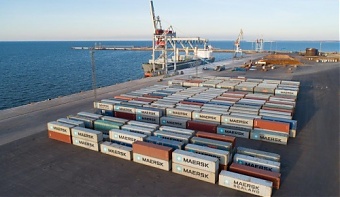Baltic States – CIS, Estonia, EU – Baltic States, Good for Business, Port, Transport
International Internet Magazine. Baltic States news & analytics
Thursday, 25.04.2024, 18:31
Adriatic-Baltic freight corridor offering hope for Estonian ports
 Print version
Print version |
|---|
According to a report on the development scenarios of maritime freight traffic in Estonia recently prepared by the Foresight Center, of the main ports on the eastern shores of the Baltic Sea, ports in Lithuania, Latvia, Poland and Russia have demonstrated growth in freight volumes in the period from 2010 to 2018.
"During the past two decades, Estonian ports have been affected by two trends -- a steep reduction in east-west transit compared with its peak in 2006, and a continuous increase in freight shipments connected with Estonia's exports and imports. At the same time, these have not offset the decline in transit shipments," Danilov said in a press release on Tuesday.
Sten Anspal, senior analyst at the Centar center for applied research, observed that the flow of transit goods from Russia has not discontinued completely, as also at present fertilizers, ammonia and oil products are shipped to the West from Russia via Estonian ports.
"The port of Sillamae has emerged as the biggest transit port. The biggest port in absolute terms is the port of Tallinn; together with the port of Sillamae they account for 84 percent of the total freight turnover of Estonian ports," Anspal said.
Anspal pointed out that in the past decade, freight handling volumes at the Baltic Sea ports of Russia, such as at the port of Ust-Luga, have been increasing faster.
"Russia has itself the goal to direct as big a portion of freight flows via its own ports, which has significantly increased their freight volumes," the senior analyst said.
Freight handling has grown at a significant rate also at the port of Klaipeda in Lithuania and at Gdansk in Poland. "Also the freight turnover of ports in Latvia has grown a bit, while that of Finland has declined. The biggest decline compared with 2010 has taken place in Estonia," Anspal said.
According to Danilov, companies that are established with the logistical possibilities created by Rail Baltic and Estonian ports in mind may bring significant freight volumes to the ports here. "Such as the soybean industry complex planned at the harbor of Muuga, whose throughput of raw materials and the end product via the port of Muuga is estimated to amount to 2.5 million tons," she said.
Danilov said that also the developments concerning Finland's trading volumes with Southern Europe, Turkey, India and other countries of Asia will prove important for the dynamics of freight volumes via Estonian ports.
The Foresight Center is a think tank at the Estonian parliament. Its tasks include analyzing long-term developments in the society, identifying new trends and development avenues, and drafting development scenarios. Operating under the chancellery of the Riigikogu, the Foresight Center bases its studies on a variety of possible developments and outlines alternative scenarios.
- 28.01.2022 BONO aims at a billion!
- 26.08.2021 LLC Dizozols Investments finalizes investment attraction deal with Crowdestor with record-high profits
- 13.02.2021 Моя жизнь в газете. Очерки по новейшей истории Латвии. Глава 1
- 30.12.2020 Накануне 25-летия Балтийский курс/The Baltic Course уходит с рынка деловых СМИ
- 30.12.2020 On the verge of its 25th anniversary, The Baltic Course leaves business media market
- 30.12.2020 Business Education Plus предлагает анонсы бизнес-обучений в январе-феврале 2021 года
- 30.12.2020 Hotels showing strong interest in providing self-isolation service
- 30.12.2020 EU to buy additional 100 mln doses of coronavirus vaccine
- 30.12.2020 ЕС закупит 100 млн. дополнительных доз вакцины Biontech и Pfizer
- 29.12.2020 Latvia to impose curfew, state of emergency to be extended until February 7








 «The Baltic Course» Is Sold and Stays in Business!
«The Baltic Course» Is Sold and Stays in Business!

